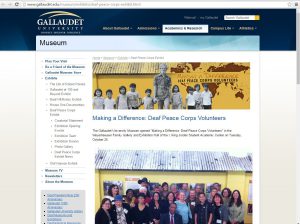Alan Crew used letters to describe experiences in Benin City, Nigeria to his family in the United States. Included in his donation to the PCCA, a memoir—compiled years after his experience—contains typed copies of the letters he wrote home, as well as transcriptions of audio tapes and photos. His letters capture the excitement and hard work of serving in the Peace Corps.
Working as a teacher at the Edo Boys’ School, Crew taught literature, English grammar, and French. The Boys’ School, surrounded by an old rubber plantation, appeared to be a difficult assignment. In a January 19, 1965 letter home, Crew wrote “The school has real problems and as Sam Selkow, our regional representative (administrator in charge of the Midwest Peace Corps volunteers) says, –it’s the most challenging assignment he’s ever given anyone.” Despite the challenges that lay ahead, Crew eagerly admitted,
The veteran Peace Corps volunteers are really exciting, and as independent as anything I’ve ever seen or imagined. I guess that the living alone does it to you, but man are they self sufficient. I get the feeling that they’d be right at home on the moon! The next two years look to be tough, challenging and intense. I think I’ll like it.
Based on his letters, Crew’s possession of a motorcycle enhanced the overall experience in the Peace Corps. On January 22, 1965, Crew informed his family about the new mode of transportation. “My school has just provided me with a rather large motorcycle for transportation, and, as you can imagine, I’m having a ball with it. As the Peace Corps supplies us all with crash helmets, the danger of serious injury is lessened, so you needn’t worry.”
This isn’t the only time he mentions his motorcycle in letters home. As Crew adjusted to living in Nigeria, he also got used to traveling by motorcycle. On January 27, 1965 Crew wrote,
My motorcycle is running beautifully, although it still isn’t completely broken in. I can understand the almost reverent feeling the old volunteers have for their machines, as they afford one the only means of mobility available…There are 104 of us within 125 miles of each other so that we can all get together on weekends if we like. Therefore, the mobility of the motorcycle takes on a new dimension of importance.
By reading Crew’s letters, it is easy to get a sense of what’s important. They also possess insight into the volunteer’s thoughts about their experiences, how they dealt with the challenges that arose (being in a new country, work, living conditions, illness, etc.), as well as what they did for fun. Peace Corps volunteers’ letters, like Crew’s, also convey their attitudes and feelings towards a range of topics. Crew claimed in a letter on March 10, 1965:
Whoever said that P.C. life was dull and frustrating must have had his head in the ground. I’ve got so much to do now that I don’t know when I’m ever going to find time to feel bored. And you talk about excited! Why, man, there’s a great big world outside of the states that I didn’t even know existed until I left. It’s really a sin more people don’t see it.






















